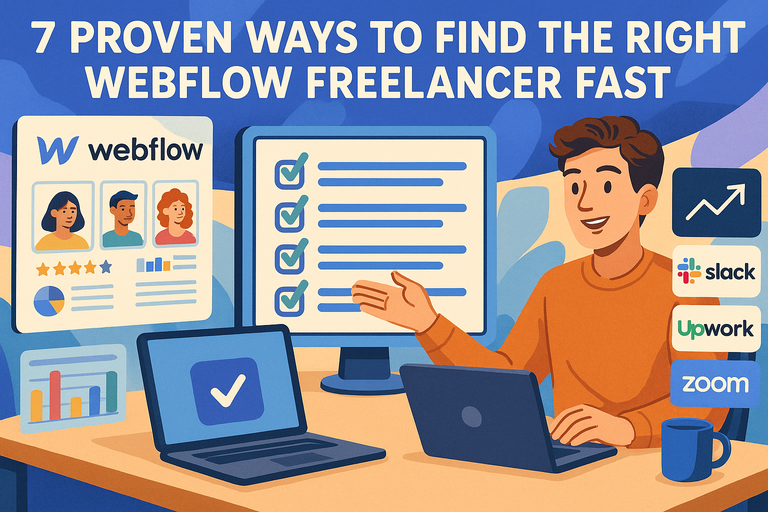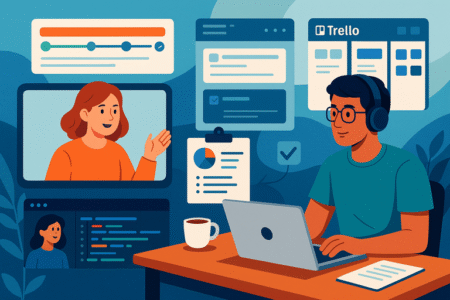Table of Contents
Finding the right webflow freelancer can feel overwhelming when deadlines are tight and quality matters. With so many designers and developers out there, how do you know who’s truly a fit for your project? The good news is, there are proven ways to speed up the process without sacrificing results.
In this guide, I’ll break down seven practical strategies that answer one big question: how can you quickly identify the right webflow freelancer who delivers on time, on budget, and with style?
1. Use Specialized Webflow Job Boards And Marketplaces
When time is short, the fastest way to connect with a qualified webflow freelancer is to look in the right places.
General freelance platforms can work, but specialized job boards and marketplaces designed for Webflow projects will save you hours of searching and vetting.
Browse Curated Platforms Built For Webflow Projects
If you’ve ever used a generic platform like Upwork or Fiverr, you know how much noise you have to sift through. You’ll get applicants ranging from WordPress specialists to Shopify developers—when all you really need is someone who lives and breathes Webflow.
That’s where platforms like Contra, Toptal, and even Webflow’s own Marketplace shine. These sites pre-vet their freelancers and filter results based on Webflow-specific expertise.
Think of it like ordering from a specialized restaurant menu instead of a buffet—you don’t waste time looking at dishes you’ll never eat. You get curated talent ready for Webflow design, interactions, CMS setup, and custom code.
Quick tip: Always use search filters. For example, on Contra you can narrow down by skill (Webflow), budget range, and availability. That way you’re not manually skimming irrelevant results.
Compare Portfolios Directly On Freelancer Profiles
A strong Webflow portfolio says more than a résumé ever could. Look for projects that match your style and industry.
For instance, if you’re running a SaaS startup, prioritize freelancers who’ve built modern, conversion-focused landing pages rather than someone who’s only done portfolio sites for photographers.
Most marketplaces let you preview full projects right from the freelancer’s profile. Don’t just scroll quickly—click into the live links. Test how pages load, how animations feel, and whether the design translates well on mobile. These are real-world signals of how they’ll handle your project.
Pro insight: A polished design that looks great but loads slowly on mobile is a red flag. Webflow is powerful, but only in the hands of someone who balances creativity with performance.
Check Ratings, Reviews, And Completion History
Even the slickest portfolio can be misleading. That’s why reviews and completion history matter so much. Look for:
- Consistency: Do they deliver projects on time, not just once but repeatedly?
- Detail in feedback: Glowing but vague reviews (“Great job!”) don’t tell you much. Strong reviews mention communication, meeting deadlines, and solving specific problems.
- Repeat clients: If people keep coming back to the same freelancer, it’s a strong signal of reliability.
Completion rate is another hidden gem. A freelancer with a 100% completion rate is less likely to ghost you halfway through.
I personally suggest giving more weight to freelancers with fewer projects but excellent reviews than someone who has dozens of half-finished gigs.
2. Leverage Webflow’s Official Expert Directory
If you want the safest shortcut to quality, Webflow’s own Expert Directory is your best bet. It’s basically a curated list of freelancers and agencies that Webflow itself has verified.
Search By Niche, Budget, Or Project Size
From the Expert Directory dashboard, you can filter by categories like:
- Type of work: Landing pages, eCommerce, CMS setups, or complex custom builds.
- Budget range: Whether you need a quick $1,000 project or a full $20,000 redesign.
- Team size: Solo freelancers vs. full agencies.
This isn’t just helpful—it’s strategic. Instead of wasting time reaching out to someone who doesn’t touch eCommerce, you can immediately filter down to experts who specialize in it. That way you’re only seeing matches who are already aligned with your project needs.
Explore Verified Portfolios And Client Feedback
Unlike random marketplaces, Webflow vets these experts before listing them. That means every profile you see already passed a quality bar. Still, don’t just take the listing at face value. Open their verified portfolios and compare them to your vision.
For example, if you’re a DTC (direct-to-consumer) brand, look for projects where they used Webflow’s native CMS and integrated tools like Memberstack. These details show whether they can think beyond design and handle functionality too.
Client feedback here is also stronger than generic reviews elsewhere, because the directory is tied to actual Webflow projects. When you read that a freelancer “scaled our Webflow site to handle 50+ blog posts per week,” you know it’s real-world experience.
Contact Multiple Experts Before Deciding
One mistake I see people make is falling in love with the first freelancer they click on. Even inside the Expert Directory, you’ll find a range of personalities, styles, and communication approaches.
I recommend contacting at least three. Share a short project brief with each one and ask:
- How would you approach this project?
- What’s your typical timeline for something like this?
- Do you include revisions in your pricing?
You’ll be surprised how differently they respond. Some might give you a thoughtful plan within 24 hours, while others reply with a generic template. The difference will show you not just their skill but their professionalism.
3. Post Targeted Job Ads On Freelance Platforms
General freelance platforms can feel like a noisy marketplace, but if you approach them with precision, they can deliver excellent Webflow talent quickly.
The trick is in how you write and filter your job posting.
Write Clear Job Descriptions That Attract The Right Talent
A vague job ad like “Need Webflow help” will flood your inbox with irrelevant pitches. Instead, be specific. Write your description as if you were explaining it to a friend who’s not technical. For example:
- Instead of: “Need a Webflow developer.”
- Write: “I need a Webflow freelancer to build a responsive 3-page landing site. The site should include an interactive pricing table, CMS-driven blog section, and must be optimized for mobile.”
I suggest including:
- Scope: Number of pages, features, integrations.
- Deadline: Clear timeline (e.g., “Deliver first draft in 10 days”).
- Budget range: Even if rough, it sets expectations.
On Upwork, you’ll find this under Jobs > Post a Job. From there, add “Webflow” as a keyword in the skills section so the platform automatically tags your listing for freelancers with that expertise.
Use Filters To Narrow Down Webflow-Specific Skills
Once applications start rolling in, filters become your best friend. Platforms like Upwork and Fiverr let you narrow results by:
- Skill tag: Select “Webflow” to exclude unrelated designers.
- Experience level: Entry, intermediate, or expert.
- Location or time zone: If you need overlap for real-time meetings.
In my experience, using the “Project Type > Web Design > Webflow” filter cuts through 80% of mismatched applicants. It’s worth taking a few minutes to apply these filters—it saves hours of reviewing irrelevant portfolios later.
Test Responsiveness With A Small Trial Task
Before committing, I recommend assigning a micro-task. This could be something like:
- Rebuilding a single landing page section in Webflow.
- Setting up a CMS collection with 2–3 entries.
- Fixing a responsiveness bug on mobile.
The point isn’t perfection—it’s to test how they communicate, how fast they deliver, and whether their style matches your expectations.
Think of it as a “first date.” You’ll quickly learn if they’re worth the long-term relationship. In fact, according to Upwork’s 2023 data, clients who tested freelancers with trial tasks had a 32% higher success rate on full projects.
4. Network Inside Webflow Communities And Forums
Sometimes the fastest way to find a trustworthy Webflow freelancer isn’t through job ads—it’s through community connections.
Webflow’s own ecosystem is vibrant, and tapping into it can help you find freelancers who already have a reputation among peers.
Join Active Webflow Groups On Slack And Facebook
Webflow has a surprisingly engaged community across Slack channels, Facebook groups, and Discord servers. These aren’t just random chatrooms—they’re active spaces where designers share their builds, troubleshoot bugs, and recommend each other for work.
A few worth checking out:
- Webflow Official Slack Group – Great for connecting directly with developers.
- Webflow Designers Facebook Group – Active with thousands of members.
- Makerpad (No-Code Community) – A broader no-code group but strong for Webflow too.
When you join, don’t post “Looking for freelancer” right away. Instead, introduce yourself, engage in a thread, and then ask for recommendations. It builds trust and usually attracts more thoughtful responses.
Engage With Designers Sharing Real Project Work
One of the biggest advantages of community spaces is seeing live examples. Members often share “work in progress” links or finished Webflow projects. This lets you judge quality in real time, without the polished filtering of portfolios.
If you see someone posting a project that matches your style, reach out privately. A simple message like:
“Hey, I loved the way you handled the animations in your last Webflow build. Are you open to freelance work?”
This works far better than cold messaging strangers on LinkedIn because it’s context-driven—you’re showing genuine interest in their work.
Ask For Recommendations From Experienced Members
Communities thrive on referrals. I’ve seen multiple posts where someone says, “Looking for a Webflow expert who can handle eCommerce setups,” and within hours, 5–10 members tag trusted freelancers they’ve worked with.
What makes this powerful is credibility. Instead of random applicants pitching you, you’re being pointed toward freelancers who’ve already delivered quality work for someone else.
Pro insight: I suggest posting during peak hours (usually late afternoon EST for Webflow communities). You’ll get faster responses and more engagement.
Quick Comparison: Job Ads vs. Community Networking
| Approach | Speed | Quality Control | Best Use Case |
| Job Ads | Fast if filters are used well | Mixed (requires vetting) | When you need structured applications and multiple options |
| Communities | Slower upfront, but often better matches | Higher, due to peer recommendations | When you want trusted, reputation-based hires |
5. Check Social Media And Design Portfolios
Sometimes the best Webflow freelancers don’t spend their days on job boards—they showcase their work directly on social platforms and design portfolio sites.
If you know where to look, you can uncover talent that matches your exact vision.
Explore LinkedIn For Freelancers With Webflow In Their Skills
LinkedIn is more than just a job board—it’s a living database of professionals. Start by typing “Webflow freelancer” or “Webflow developer” into the LinkedIn search bar, then filter results by People.
- Pro move: Use location filters if time zones matter. For example, if you’re in New York and need overlap, filter for “United States.”
- Look for freelancers who list Webflow under Skills or Experience. Click into their profiles to see if they’ve tagged projects with client case studies or links to live Webflow sites.
I’ve personally found some of the best freelancers by sending a simple, polite message:
“Hey [Name], I saw your Webflow portfolio on LinkedIn. Are you currently taking on freelance projects?”
It’s less formal than a job post, but it often sparks a quick conversation with highly skilled professionals.
Use Dribbble And Behance To Spot Creative Styles
If design aesthetics are as important as functionality, Dribbble and Behance are goldmines. These platforms are built for visual discovery. Type “Webflow” into the search bar, and you’ll find portfolios tagged with the keyword.
- On Dribbble, you’ll see small preview shots of websites. If a design catches your eye, click through to see the full case study. Many designers include direct links to their Webflow builds.
- On Behance, projects often include detailed descriptions, showing not just the visuals but the problem-solving process behind them.
This is a great way to gauge whether someone’s creative style matches your brand identity. A bold, colorful SaaS design might look amazing, but if you run a minimalist lifestyle brand, you’ll want someone with a softer, refined portfolio.
Follow Webflow Hashtags On Twitter And Instagram
Freelancers often showcase their latest work where it’s easiest to share: Twitter and Instagram. Start by following hashtags like:
- #webflowdeveloper
- #webflowfreelancer
- #madeinwebflow
Scrolling through these tags, you’ll find live site links, quick demos, and micro case studies. What I love about this method is you see designers in real time—not just their polished portfolios.
Comment on posts you like, then send a direct message. This approach feels more human and often leads to freelancers who are excited to collaborate.
6. Prioritize Direct Referrals From Your Network
One of the fastest and most reliable ways to find a good Webflow freelancer is through word of mouth. People in your own network have already worked with freelancers, meaning you get pre-vetted recommendations.
Reach Out To Colleagues Or Agencies You Trust
Start simple: send a short email or Slack message to colleagues or partners you trust. Something like:
“I’m looking for a Webflow freelancer for a new project. Have you worked with anyone you’d recommend?”
Agencies are also a great source. Even if they can’t take on your project, they often have overflow work and will happily refer you to freelancers they trust.
Ask For Freelancers With Proven On-Time Delivery
A key quality in a freelancer isn’t just design skill—it’s reliability. When you ask for referrals, make sure you clarify that you need someone who delivers on time. It’s better to get a recommendation for a dependable mid-level freelancer than a brilliant designer who regularly misses deadlines.
In fact, a 2022 Bonsai report found that 43% of clients ranked “on-time delivery” as more important than “creativity” when hiring freelancers. That says a lot about how much consistency matters.
Request To See Example Projects Before Contacting
Once you get a referral, don’t jump straight to hiring. Ask the person making the recommendation to share a couple of example projects the freelancer delivered. This gives you a chance to check for alignment with your industry and style.
For example, if you’re building an eCommerce store, make sure the freelancer has worked with Webflow’s eCommerce functionality before, not just static landing pages.
7. Evaluate Candidates With A Clear Vetting Process
Even when you find a promising Webflow freelancer, the vetting process makes or breaks the hire. Rushing here often leads to mismatched expectations, so take a structured approach.
Ask For A Custom Proposal Or Design Sample
Don’t rely on generic cover letters. Instead, ask shortlisted freelancers to share a short proposal for your project. A good proposal should outline:
- Their understanding of your goals.
- A rough timeline with milestones.
- Suggested tools or integrations (e.g., CMS, Zapier, Memberstack).
If you’re unsure, request a small design sample, like a homepage wireframe. This shows you how they think and ensures their approach matches your brand.
Discuss Communication Tools And Project Management Habits
Great design is useless if communication is messy. Ask them upfront:
- Do you prefer Slack, email, or another tool for daily check-ins?
- Do you use project management tools like Trello, Asana, or Notion?
- How often will you share progress updates?
For example, one freelancer I worked with preferred using Loom videos to walk through design changes instead of long written updates. It saved hours of back-and-forth.
Set Clear Timelines And Pricing Before Starting
The final step is alignment. Before signing anything, make sure you agree on:
- Timeline: Exact dates for drafts, revisions, and final delivery.
- Pricing model: Flat fee vs. hourly. Personally, I suggest flat fees for well-defined projects—it avoids surprises.
- Revisions policy: How many rounds of revisions are included before extra costs apply.
Clear upfront agreements prevent scope creep and give both you and the freelancer confidence.
Expert Tip: Speed Doesn’t Mean Sacrificing Quality
I know the pressure to find a freelancer fast can feel overwhelming, but moving quickly doesn’t mean lowering your standards. The trick is combining speed with structure. Use job boards and social media for efficiency, but always pause to check portfolios, reviews, and responsiveness.
A rushed hire might save you a day, but a poor match can cost you weeks in missed deadlines and rework.
I suggest building a shortlist of three candidates, testing them with small tasks, and then moving forward with the one who delivers best. That balance of urgency and due diligence is the real “fast track” to finding the right Webflow freelancer.






